The Danish composer Fuzzy has musically decorated The Black
Diamond with his work Katalog (Catalogue) which is inspired by the treasures of the
library and presents 52 electro-acoustical works of which one is played every day at 1.00-1.03 p.m. - a new
work every week.
The music can be heard in the big atrium of the library (called "The Chip") between the
balconies, glass walls and transverse bridges.
Below we present the pictures and a short description of the objects from the library which
have inspired Fuzzy for the music of the individual weeks in November and December (week no. 45-52).
Back to the index
Week 45
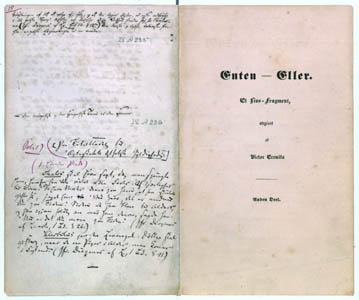
Søren Kierkegaard's own copy of the first edition of Either-Or from 1843. Kierkegaard usually took care
that either presentation copies or those for himself were particularly well bound. This volume is covered with white
moiré paper with a pattern in gold. It contains handwritten notations for a new edition, which appeared in 1849.
Manuscript Department, The Søren Kierkegaard archive, A 44b, oktavo, previously at the University Library.
Week 46
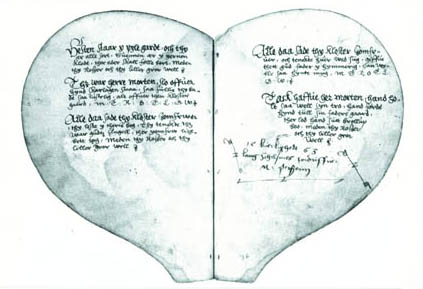
The Heart book which contains a collection of ballads, written down c. 1553-55 by the noblemen and court
official Albert Mus. The dating of the ballads is an issue of scholarly dispute, since the earliest ballads
most often are only known from copies made in the mid-1500s or later. The oldest collections were usually,
like this one, produced at court or by the nobility. Shown here is the end of the ballad of Herr Mortens Klosterrov
with a sententious addition made in 1553 by another courtier, Mogens Pedersen (Galt): Kærlighed lang skilsmisse
fordriver - Love survives long separation.
Manuscript Department,
Thott 1510, kvarto. More about the manuscript.
Week 47
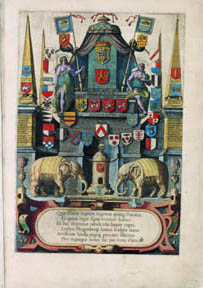
Engraved frontispiece from a copy of Georg Braunius & Frans Hogenberg's collection of city views and plans,
Civitates orbis terrarum IV (Köln 1588, folio) with a printed dedication to Frederik II. Hogenberg's
monumental composition shows not only the heraldic symbols of the Danish-Norwegian state, but also the coats of
arms of the 21 members of the Council of State. In the mid-foreground, a small tower bears the arms of Ösel
and below them the initials of Fredericus Secundus. The tower is flanked by two elephants, an allusion to
the king's revival of the Order of the Elephant, by which the elephant became a symbol of Denmark and
its royal house.
The Map Collection
Week 48
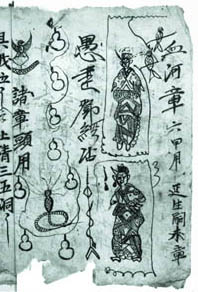
Taoist manuscript conjuring handbook from Yunnan provice dated 1813. Two shamans are depicted
with life-giving and protective symbols: birds, snakes and a double gourd.
Oriental Collection, OA ms. oktavo.
Week 49
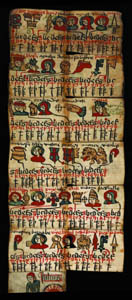

A great rarity, a Danish illustrated calender from 1513 (a perpetual calender in Latin), perhaps made in Scania.
When folded up the manuscript is not much larger than a large matchbox, but the calender, as shown, can be
unfolded and provides quite a lot of information.
To the right: The pictures for each month from July to December. The light and dark hours of the day are
indicated by red and black lines respectively in rosettes, and each month is illustrated by its typical form of
labour. July: haying with a scythe, August: grain harvest with a sickle (a woman), September: threshing with
a flail, October: sowing of winter seed, November: slaughtering, December: baking (again a woman).
To the left: List of the red-letter days from the months of January (at the top) to June (at the bottom).
Illustrations were used to help the illiterate, in part 'portraits' of the saints or other figures, in part
rebus-like symbols. Three crowns represent Epiphany (Jan. 6) and a lion, the evangelist Mark's day (April 25).
Particularly entertaining is the illustration for February 10 Scolastica (virgo), i.e. the learned
virgin St. Scolastica's day. The reminder for the day uses the Danish mening of the first syllable of
her name - sko (a shoe!).
Manuscript Department, Ny kongelige Samling 901, oktavo.
Week 50
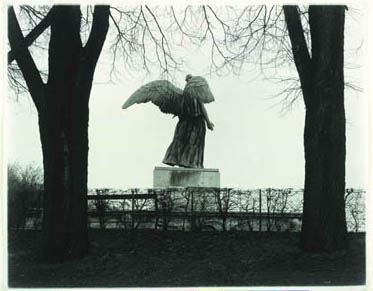
Per Bak Jensen (Danish): From the series The Enegmatic City. Silver gelagine barites paper,
383 x 494 mm.
The National Museum of Photography.
Week 51

With a laterna magica, which projects onto a wall, a picture is shown of busy thieves enriching themselves
while a policeman has fallen asleep. A satire on the police in a series of seven broadsheets entitlet
Kjøbenhavns Skilderie (Pictures of Copenhagen), engraved in 1787 by J.F. Clemens after a drawing by Nicolai
Abildgaard.
Prints and Photograph Section
Week 52
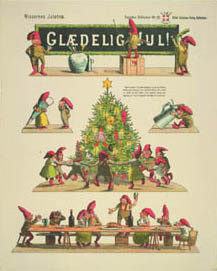
Danish Pictures No. 26. The Christmas Tree of the Pixies (pictures with transparence, a Christmas tree
to lighten up etc.) 1889.- Publisher Alfred Jacobsen, Copenhagen.
Prints and Photograph Section .
Back to the index
Comments for The Music and Theatre Department
Updated September 2004










